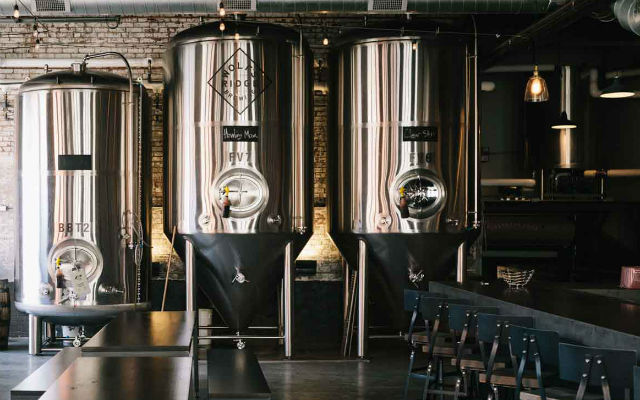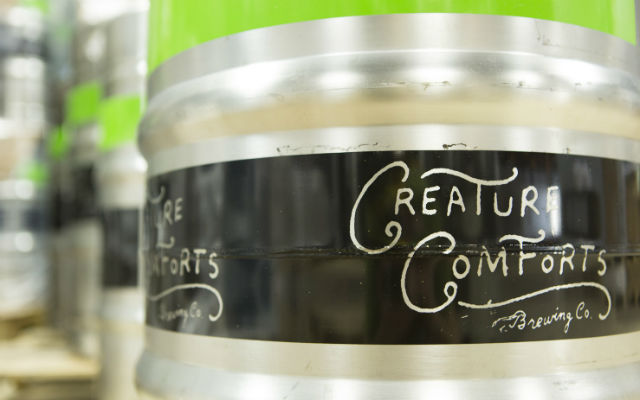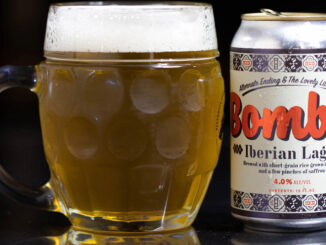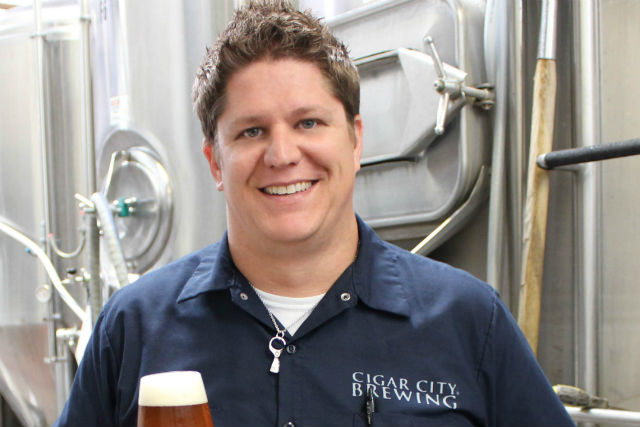
Wolf’s Ridge has been working on a number of collaborations with other fellow Ohio breweries lately and head brewer Chris Davison said he has learned a lot about what makes for a good collab experience. The head brewer for the Columbus, Ohio-based brewery has recently worked with Platform, Listermann, DopTap Columbus (Brew Dog’s Ohio tap room crew), plus a three-brand collaboration brew with Urban Artifact in Cincinnati and Market Garden in Cleveland for a beer that represented the three major cities of Ohio to name a few.
BREWER: What have been a few key takeaways you get in working with other breweries?
DAVISON: You get to spend time with other brewers! While it sounds obvious, this job tends to be very physical and the hours are long. Sometimes the last thing we have energy for is going out after work to hang out and talk shop or drink someone else’s beer. This is unfortunate though, because everyone really does want to do this, it’s just that often life gets in the way — at least for those on my team that are married, live outside downtown, have children, or are not 25 anymore!
So, working with other brewers helps in many ways, including that we get to know them. This is the best reason for doing a collab I have discovered. I went into my first few expecting to learn all these new techniques and combine forces to make something better than the sum of its parts. In reality, the most rewarding thing is putting a face to the beer being brewed across town, upstate, or somewhere else in the region. Collaborations have only reinforced that brewers are good, hardworking, passionate people. I think in every collab I’ve ever done I’ve walked away with more respect for the other brewery than I had prior to the experience — which is reward enough for me.
But, working with others does also occasionally give rise to new ideas and lead to positive improvements to methodologies or philosophies on ingredients.
BREWER: How does a collab work different than working among your own brew team?
DAVISON: It’s tougher to get the ball rolling since we’re often getting the initial stages planned out via phone or email. It’s also really tough sometimes coordinating a brew day since we’re trying to get people from at least two different breweries together on the same day to brew a beer (which takes 8-10 hours on average). If I need to travel to Cincy to brew, I’m not getting anything done at Wolf’s Ridge that day. So sometimes it can takes weeks or months of planning before everyone can actually get together to make the beer happen.
BREWER: What is your style and how do you convey that in the product?
DAVISON: My style is to experiment but in restrained and unique ways. At Wolf’s Ridge there are certain styles or processes we stray away from so I typically avoid those in beers we brew outside of WRB as well. I feel like most of my collabs to date have focused on using an unusual yeast, grain, or hop profile to push the boundaries of style. We’ve done a dry hopped Kolsch, an American Pale Ale brewed with 100% German sourced ingredients (grain, hops, and yeast), and an Imperial Stout with heavy doses of wheat or rye to name a few.
BREWER: Have you been doing these mostly at their breweries or at Wolf’s Ridge? How do you determine where to brew?
DAVISON: The first few we did were actually sort of pushed on us via Columbus Beer Week. Everyone’s schedule is already packed that time of year (May) so most breweries didn’t want to make a version at each collaborator’s brewery — it would have just been a lot of beer and tough to schedule it all. So we would discuss questions of who could best support the volume needed or who had the opening in their brew schedule. More recently, we’ve let things fall into place more naturally. We did a sour beer with Market Garden and Urban Artifact this past spring called WARMUG. At the time, Urban Artifact was the only one of the three breweries who made sour beer at volume so the decision to brew there was fairly simple. The last two collabs I’ve done wound up seeing a version of the beer brewed at each brewery. Each brewery can squeeze it in their own schedule wherever it fits. This somehow seems easier than a single location for whatever reason, plus you wind up with the fun opportunity to compare the two beers side by side.
BREWER: How does brewing at their place or your place affect logistics and release?
DAVISON: The way beer is regulated this is actually a simple question. The brewer who makes the beer owns it. The name, the sales, etc. So the Ryewine we made at Platform Cleveland called Panic Switch was theirs to package, sell, and manage. Our version is called DEFCON Red and will be up to us to handle. The main thing I always forget about until the last minute is ensuring we reserve a few kegs to serve at our own taproom of a collab that was brewed elsewhere.
BREWER: What sort of marketing and events do you do to promote the product?
DAVISON: Often sales reps from each brewery will coordinate joint tap takeovers at retail accounts. Usually each brewery will tap kegs of the beer(s) in house as well. I haven’t done many collabs that went into a bottle or can yet, and none internally, but the other brewer often does a release party to promote the new beer. We’ll likely see a big turnout for some future collabs though so we’ll host a larger release events and bring in some special guest drafts for the occasion.
BREWER: How does a collab help your brewery in getting your name out to consumers than may not have before?
DAVISON: A collab is a great way to get your name out to new customers. Even locally, there are people who are super loyal to only a few breweries. When I collaborate with one of those breweries, that customer suddenly has a new reason to come try my beer or think about Wolf’s Ridge. Collaborating often means getting your beer or name into new markets as well. While we do not distribute to Cincinnati, people down there know our name now because we’ve done two collabs in the past year with a Cincinnati brewer. This will hopefully make sales easier when we do officially enter that market down the road. Finally, a collaboration, especially if the consumer is fond of all breweries involved in the project, is an easy sell. Collabs tend to be fun and compelling. It’s hard to resist trying the brainchild of two of your favorite breweries’ combined efforts.
BREWER: What do you think has been your most successful collab and why do you feel it was successful?
DAVISON: I have two projects going now that are just entering barrels this month — to rest for around a year. So those both might prove super successful in time. But to date, my most successful collab was WARMUG, brewed between us, Market Garden, and Urban Artifact. It was a learning experience as well as a hell of a lot of fun. It was my first real introduction to large scale wort-souring, the usage of fruit purees, and adding coffee to a sour. Yeah, this thing was also our most unique and “out there” collaboration beer. The label called it a “Golden Fruited Coffee Sour”. We started with golden sour wort, added peach, passionfruit, and plum, then infused it with a beautiful light roast Costa Rican bean from One Line Coffee (another frequent collaborator of mine). The result was odd and delicious and just fun. It had wonderful art, and the name was an appropriate anagram of the initials of each participating brewery. Most importantly we made some friends for life in the wonderful people at Urban Artifact and Market Garden.







Be the first to comment